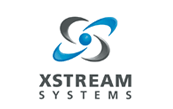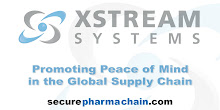
The is the second and final installment of a two part opinion blog by Alan Clock, Senior Vice President at XStream Systems, Inc.
How do we as a society both domestically and globally solve this growing threat and eliminate the danger that looms as its deadly consequence to us all?
We now live in a worldwide, global economy. Trade and industry superpowers have emerged beyond the traditional European and North American developed nations. Comprehensively all industries have had enormous movement of production into underdeveloped nations, even those that have a tradition of trade riddled with fraud, counterfeiting and corruption. These countries with well know nefarious sources of supply, now find themselves as a primary producers of everyday consumer products that are in foodstuffs, household goods and medications on the retail shelves of Main Street USA.
The reality, unknown by many, is that this counterfeit phenomenon is growing and going well beyond the borders of the undeveloped world. Today, not one product, not one place, not one person is immune from the impact of counterfeit and fraudulent products. It is likely that we will continue to see this counterfeit boom continue unabated indefinitely.
How this phenomenon is happening is both complex and simple. This is a global event which adds to its complexity, but it is driven by easy money which is very straightforward to understand.
As such, some of the major factors driving the unprecedented proliferation of counterfeit products around the globe decade include:
- Global economies and worldwide supply chains. As companies become more global and procure raw materials and contract production overseas due to lower costs and expense, the supply chains become much more difficult to control and monitor. Companies lose control over their production, intellectual property and quality control. Regulatory processes and enforcement in third world countries lag behind the developed world and institutional control. Nefarious vendors can contaminate for quick profit a product by providing poor quality or adulterated raw materials prior to production. Without adequate controls manufacturers, distributors, retailers and consumers find themselves vulnerable to poor quality, contaminated or fraudulent materials. Often by the time an issue is discovered the product is well within distribution, its source difficult to pinpoint with the perpetrators long gone. Unfortunately by that time the impact of the bogus product has been borne by thousands.
- Ineffective laws and regulations. As a global economy expands, products move across multiple borders making them increasingly vulnerable and allowing for organizations to take advantage of legal loopholes, breaks in regulatory authority and the ability for law enforcement to adequately monitor movement of goods and services. Penalties for criminal activities also exacerbate the situation. A criminal organization can make more profit with less risk of being caught or with any significant legal ramifications by counterfeiting than almost any other criminal activity. Basically it is easier to counterfeit products, with much less risk and much more profit than in any other legitimate or illegitimate activity.
- Growth of the internet and unrestricted, instant access to millions of consumers. In the 21st century, counterfeit organizations can directly or indirectly market and sell their wares online, 24 hours a day in relative anonymity. These organizations can set up websites and fulfill transactions with only a few key strokes and completely camouflage their operation. By the time a regulatory body, law enforcement agency or consumer finds a fake product the marketing source or website and operation is long gone into a hazy cyber world.
- The global financial meltdown that occurred in the last half of the decade has caused many retailers and consumers to look at the price of materials, focusing less on quality and authenticity. As incomes and profits fall, so do the standards of the producer or consumer as they scramble to find the products and materials that they rely on. This is a dangerous environment where counterfeit organizations thrive. A perfect scenario for fraudulent activity occurs when members of the supply chain focus on price over cost and fraud. The criminals know that by the time their crime is discovered they have little chance of being held accountable.
- The lack of brand protection and security by members of the supply chain. Many manufacturers, distributors and retailers have been slow to realize the huge impact that counterfeit products have and could have to their businesses. Many have had and continue to show a lack of strategy in dealing with this issue, ostensibly because they have not educated themselves on the problem or they do not have the necessary solution to effectively deal with it. Regrettably until most of these organizations face the liability or brand erosion of a catastrophic event caused by fraudulent activity they simply ignore the issue altogether.
- The lack of implementation or acceptance of comprehensive solutions to combat counterfeiting. There have been scores of regulatory bodies, legislation and industry groups make attempts to implement comprehensive solutions to counterfeit activities. Most initiatives prove to be ineffective, based on their lack of acceptance, expense and their complicated approach. Functionally most of these solutions are based on a transactional approach. A transactional approach relies on the supply chain to continually interact and exchange data. This constant information exchange in real time is difficult at best and extraordinarily expensive at worst especially when you are dealing with a far reaching, global supply chain.
Additionally transactional methods only deal with the product package and not the material or product itself. Some of the largest and most egregious fraud and counterfeit events of the past several years were products that had pristine transactional pedigrees but the product on the inside of the package was adulterated or fraudulent, causing harm to thousands of end use consumers and millions in losses to the brand.
To date, most industries seem to have taken a wait-and-see approach driven by the cost of current solutions, which ultimately means that the initiatives die as the events which caused the activity loses momentum over time. The reality is that eventually business leaders within the supply chain have a “hear-no-evil, see-no-evil” attitude as it relates to this issue because they posses few answers and have little to no government or industry leadership to the mandate or guide them.
The dilemma of the next decade is how to marshal our resolve as a society globally and properly respond to the multiple factors which have driven this decade of fraudulent, adulterated and counterfeit products that have proliferated in the 21st century.
First and foremost, to win this battle, there needs to be a universal awareness of how prevalent and how dangerous this issue actually has become. Consumer’s awareness and their rejection of products that are not vetted and authenticated is critical.
Additionally, regulatory authorities across the globe need to be motivated, synchronized and resourced appropriately so as to eliminate the shadows and safe havens that allow counterfeiters to thrive.
Finally, industry and supply chains need to understand and realize the profit, loss and liability that exist if they do not deal with counterfeits head on. Each of the stakeholders of the consumer supply chain, from corporations to consumer, need to push for sophisticated solutions and eliminate this potentially deadly threat.
Vital to these three primary steps is the realization from all; manufacturer to consumer, is the understanding what this counterfeiting is currently, but what it can become if not properly addressed.
Most ominous is the potential for counterfeiting to evolve beyond the simple criminal act to becoming a massive terror threat is very real. As it stands today, millions die each year from individual criminal counterfeit acts, if done with a coordinated murderous intent; a terrorist element could comprehensively impact the health and mortality of an entire country or society.
Fortunately the solutions are at hand, today there are technologies that can be comprehensively layered to protect the various members of the supply chain, within individual channels to follow transactions, screen materials and authenticate the validity of products at each step of the sequence as it makes its way to the consumer.
One such solution is a technology known as EDXRD. This innovative technology allows the user to molecularly screen the product inside its original container without destroying or degrading the product, thus minimizing the need for Track and Trace or transactional solutions. Basically this solution adds functionality from the transactional and looking at the outside of the container to looking inside the container with Molecular Screening. Ultimately, this type of solution provides each member of the supply chain the confidence to know that their inventories safe and efficacious.
In the end, layered deployment of technology solutions, consumer awareness and a coordinated regulatory/law enforcement process will be the most effective strategy to lessen this very dangerous, criminal activity. When the criminal elements realize that there is little profit and a realistic chance that they will be held accountable for their actions, the deadly issue of counterfeit and fraudulent products will drastically decline and the Decade of the Counterfeit will become a brief historical story of how technology and public awareness save the day.
Alan Clock, Senior Vice-President of XStream Systems has over 20 years of pharmaceutical, healthcare and sales distribution experience. Mr. Clock has an impressive track record of promoting comprehensive solutions to healthcare providers, distributors, large corporate entities, group purchasing organizations, employer groups and managed care organizations. He has held senior sales executive and national account roles for major Fortune 100 healthcare industry leaders and has successfully negotiated and sold billions of dollars in multi-year pharmaceutical service, software, equipment, packaging and consulting agreements.
























